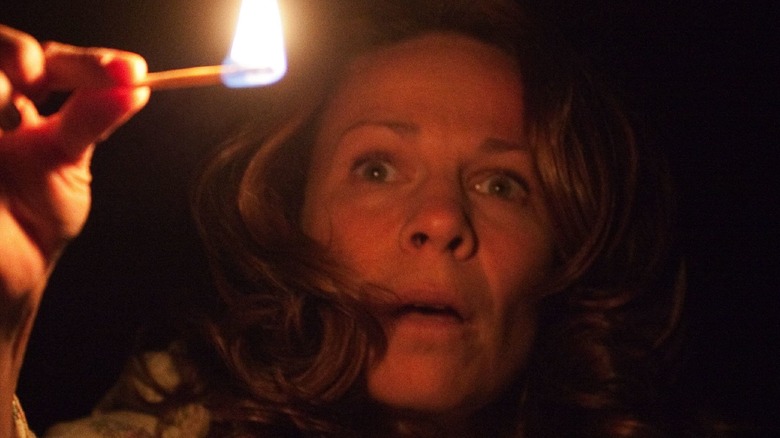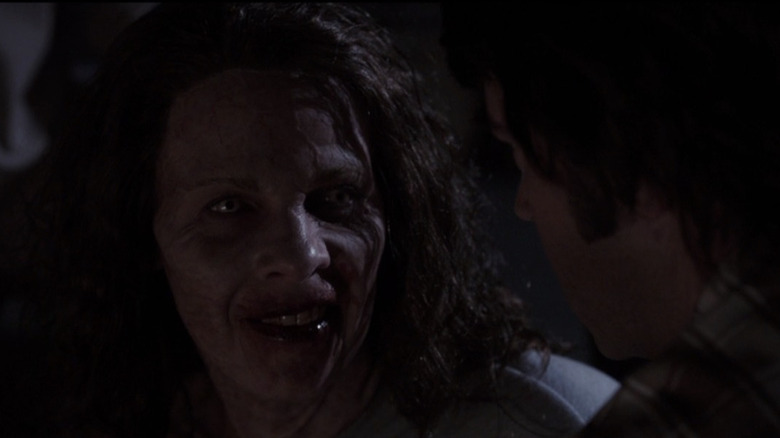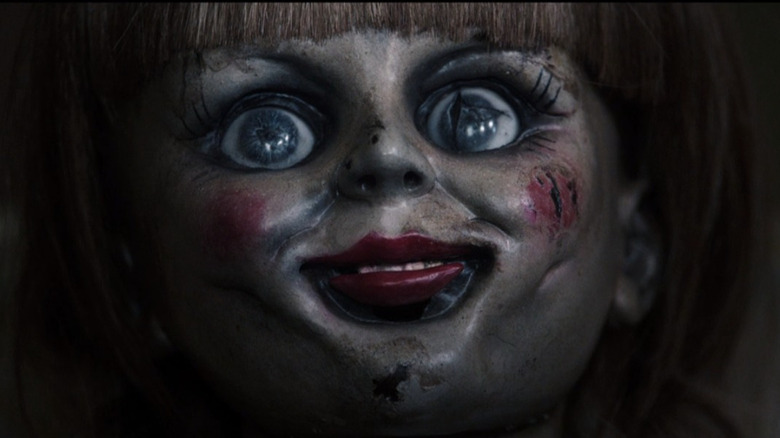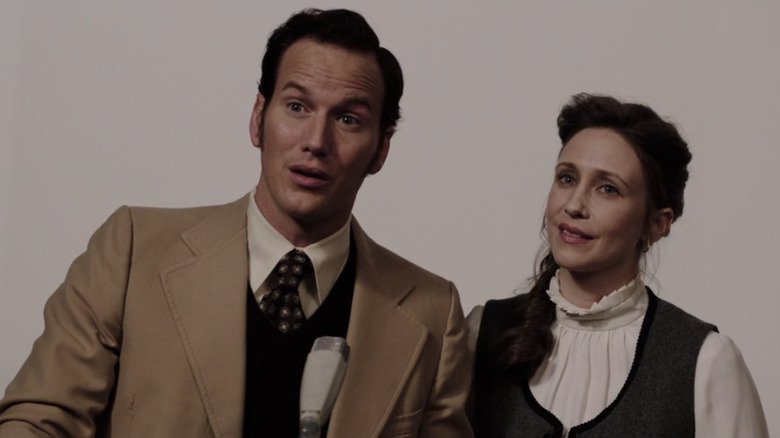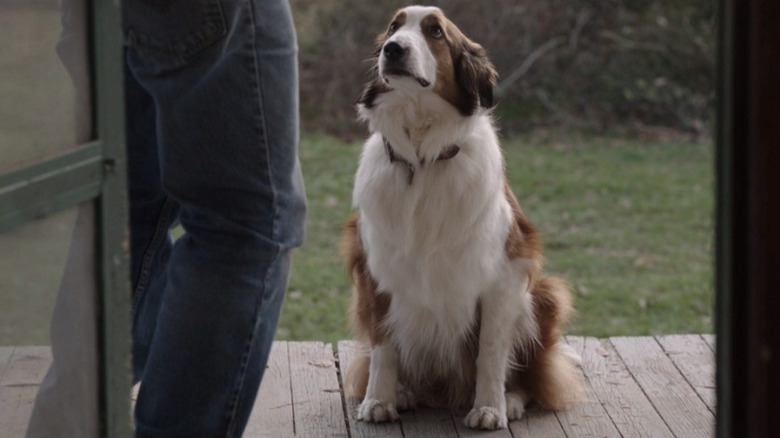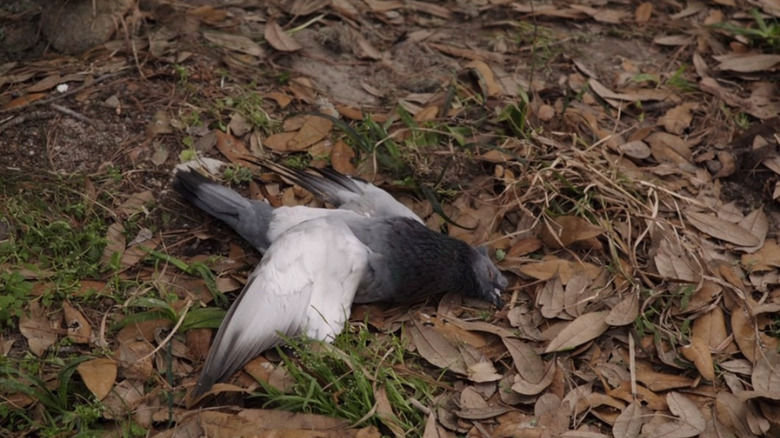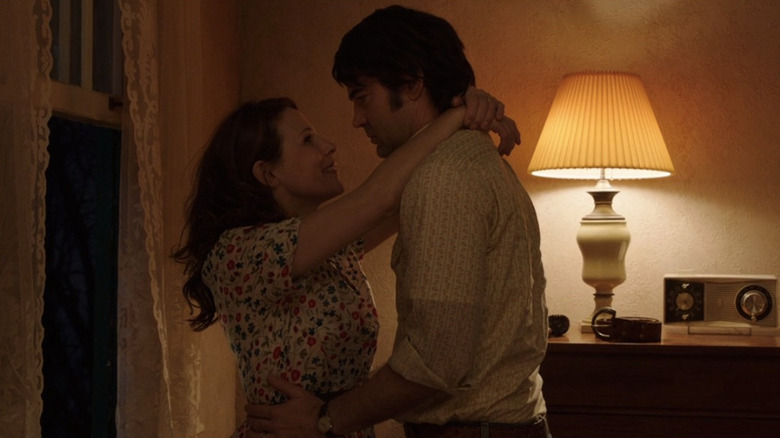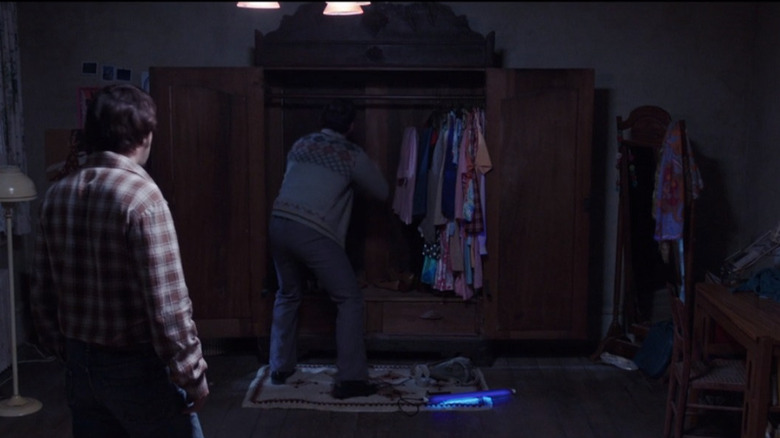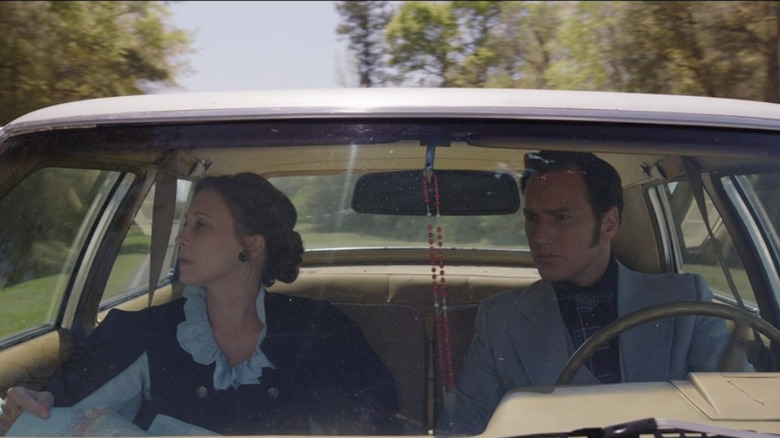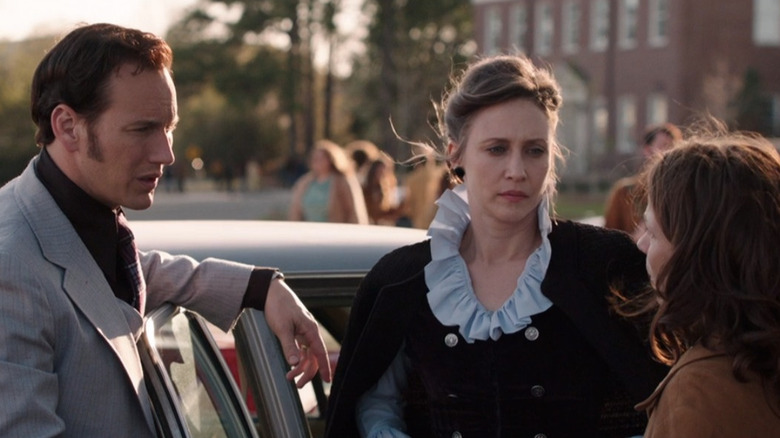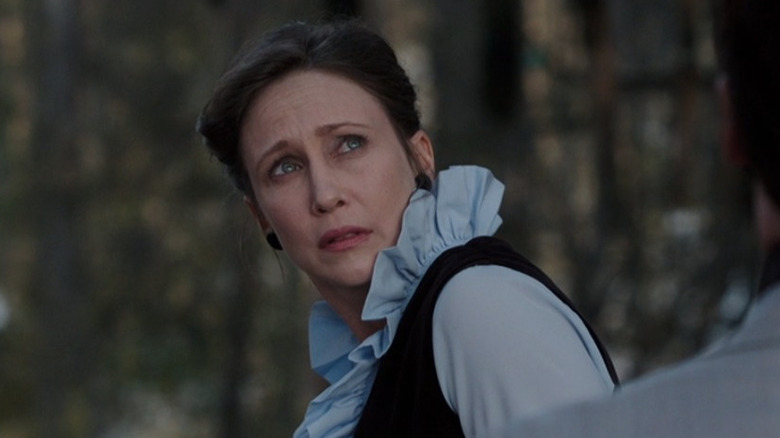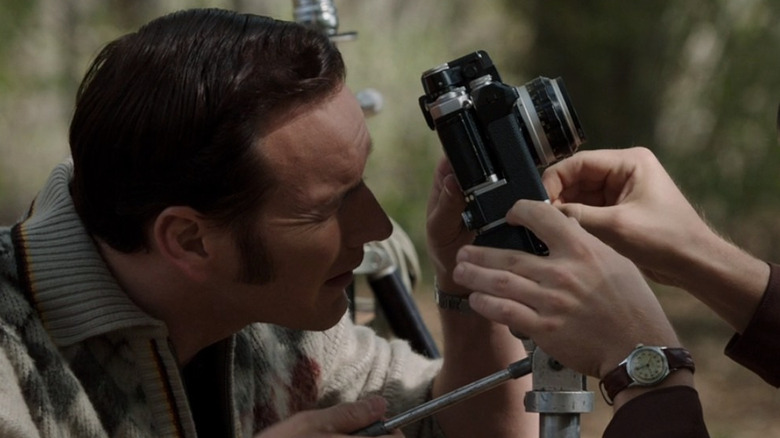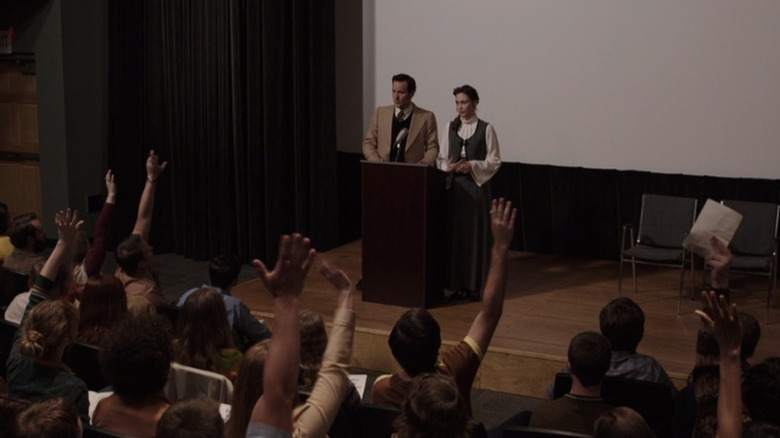Biggest Unanswered Questions From The Conjuring
In an early moment from the 2013 horror flick "The Conjuring," married couple Lorraine and Ed Warren speak to a classroom of university students about their work hunting ghosts and studying the deceased. At the conclusion of their presentation, Ed asks if the pupils have any questions. Of course, nearly every hand in the room goes up.
Fascination with the macabre is an interesting dichotomy. While it's natural to be fearful and want to avoid something that is dangerous and perhaps evil, when people come into contact with someone who has communicated with a spirit (particularly someone who seems to be a rational intellectual), it's no wonder that an entire room would have follow-up questions.
The same could be said for audience members after watching "The Conjuring," the first in what has since become a series of films within "The Conjuring Universe," including sequels and spin-offs like "Annabelle" and "La Llorona." The movie that started it all did an admirable job at establishing the lore of a world uncomfortably, perhaps, rooted in reality. When the credits roll, audience members can't help but raise hands to ask Lorraine and Ed a few unanswered questions.
How much of this was real?
"The Conjuring" is a unique brand of eeriness — based on true events.
While it's commonplace for film adaptations of real stories to twist details here and there to make for a compelling narrative, the audience can mostly accept that the shell of what they're watching happened in reality. Due to the nature of what happens in "The Conjuring," this is a bit more of a challenge on the audience's part. To accept "The Conjuring" as an accurate portrayal of history is to take on a very specific worldview about spirituality, mortality, and nothing short of demonic possession. That's a lot to ask of an audience. Even when believing what the Warrens said happened did happen, there were still a few differences in bringing this particular case to the screen, as chronicled by Entertainment Weekly.
Among the most significant differences is the case not concluding so amicably between the Warrens and their clients, the Perrons. In the movie, the Warrens perform an exorcism upon Carolyn Perron, and leave the family's home demon-free and peaceful. In reality, Roger, Carolyn's husband, told the Warrens to leave after a seance in which Carolyn lifted off the ground. According to Weird History, the Warrens returned several times thereafter in the following years, but never cast out any demons like the movie depicts. This is just a tease of a long list of differences between reality and the film.
Why were the women at the beginning so nonchalant?
The movie opens with a flashback of Lorraine and Ed interviewing roommates named Debbie and Camilla, who say their doll has become possessed. Debbie explains that they learned from a medium that "a seven-year-old girl named Annabelle Higgins had died in this apartment. She was lonely and took a liking to my doll. All she wanted was to be friends." Camilla continues, "When we heard this, we felt really sorry for her. I mean, we're nurses. We help people. So we gave her permission to move into the doll ... she wanted to live with us by inhabiting the doll. We said yes."
While the lore of Annabelle is a subplot in "The Conjuring" rather than the main story, the doll would later get a franchise of her own. Debbie and Camilla returned in that series, but only in supporting roles. Perhaps more could be inferred about their characters with more substantial exposition, but as for their brief appearance in "The Conjuring," they seem awfully relaxed given the circumstances.
Yes, Debbie and Camilla attempt to justify their acceptance of the doll's presence by saying they're good-natured nurses who want to help people — but still, it's a huge leap to go from "helping people" to believing in the presence of a dead spirit and deciding to assist it.
How do the Warrens know so much about the spirit realm?
Lorraine and Ed Warren practice a unique field of study. They answer to many titles, among them "demonologists, ghost hunters, paranormal researchers, kooks, and wackos." They make house calls to investigate and eradicate malignant supernatural presences. Their visit to the Perrons' residence in "The Conjuring" is hardly the Warrens' first rodeo. They've done this kind of thing many times before, and as such speak with authority and experience.
Even in the flashback at the beginning of the movie, the Warrens are definitive in their assessment of the potential possession of a doll, saying "Ghosts don't possess such power. I think what we have here is something extremely manipulative. It's something inhuman." That's a very exact diagnosis. How do they know this is what's happening? Where can they make such a diagnosis?
Aside from repeated exposure to similar situations, one has to wonder how the Warrens came to have such an acute knowledge of the occult. In 2021, The Connecticut Post published a revealing look at the real couple, explaining Ed Warren was "self-taught" on the subject, and the couple conducted further studies by founding the New England Society for Psychic Research. Within the film, though, the minimal context "The Conjuring" provides leaves the audience not knowing a ton about the couple's history or how they came to have their wealth of knowledge on demonology.
Can dogs really sense danger?
When the Perrons first move into their new house, their dog Sadie immediately knows something's wrong, even before any paranormal activity visibly materializes. Sadie refuses to go inside the home at all, so the family leaves her outside overnight. The next morning, April, one of the Perron daughters, is terrified to fight the dog dead, the cause of her death a mystery.
The scene plays into a long held urban legend that dogs can "sense" ghosts. But is it true? The answer is, well, kind of.
Some members of the scientific community believe canines possess what is essentially a sixth sense; a combination of already-established senses like sight, sound, and in particular smell. These heightened olfactory skills could make dogs more attuned to the sorts of terrifying things we'd primarily be trying to detect with our eyes.
"The role of the olfactory system has been largely underestimated," says Biagio D'Aniello, a zoology professor at the University of Naples in Italy. "Maybe because our own species is more focused on the visual system."
"Humans let off a very different scent depending on their state of wellbeing," a Newsweek report explained in 2021. "Meaning we smell different to dogs when we are ill." Another medical report claims that dogs have a 94% success rate in smelling stress from humans.
So, if dogs can detect stress and when people are sick, is it really that big a leap to imagine they could detect the presence of a person who is deceased?
What's the significance of the birds?
In addition to the Perrons finding their lifeless dog in their yard, Roger later encounters a bird on the ground outside, still alive but in peril. Perhaps possessed by the same ghost haunting the rest of the house, the bird writhes and flops in the dirt, unable to free itself. Later, as the Warrens perform their exorcism upon Carolyn, an armada of birds descend upon the house, banging against its exterior — one even crashing through the basement window.
As the Warrens unspool the meaning behind the Perrons' predicament, several clues connect with specific occurrences within the house. For example, they learn that a woman named Bathsheba originally lived in the house and killed her own child. Bathsheba's deceased spirit, it seems, has possessed nearly every successive tenant of the house. In particular, Bathsheba possesses matriarchs and leads them to kill their own children, explaining why Carolyn is Bathsheba's current target and why Lorraine sees visions of her dead daughter, despite her daughter being alive and well.
The Warrens never discern a comparable explanation for the birds, though. If there's any significant history to Bathsheba that involves birds or animals, such information is left to the imagination.
How early did the adults suspect something was wrong?
It takes about a third of the movie's run time for Roger and Carolyn to finally seek the aid of the Warrens in figuring out what's happening at their house. Despite multiple incidents of Bathsheba tormenting their family, the adults aren't as quick as the children to be frightened by the strange, inexplicable happenings.
That's to be expected. After all, would you want to believe your house was being demonically possessed? You'd probably first try to write it off as the kids' imaginations, or seek a rational explanation for things you saw with your own eyes. The tipping point for Carolyn is when she's taunted by Bathsheba in the basement with a series of freak movements, like a lightbulb bursting into flames and a ball rolling across the room.
One can't help but wonder how early the adults suspected demonic goings-on, but were simply too proud to acknowledge their own fear. Their dog died, Carolyn started getting unexplained bruises, and their children slept-walked and claimed to see invisible spirits, and Carolyn and Roger stood firm in their disbelief through all of it — or at least, appeared to. Deep down, did they have any uneasiness that something more might've been wrong?
Why was the wardrobe Rory's favorite hiding place?
Young April Perron first sees the ghost of a boy named Rory in her handheld mirror. As she looks in the mirror, Rory appears behind her. April can apparently communicate with Rory, and she shares that Rory hides inside the wardrobe when he's scared. The wardrobe continues to seem important throughout the film, but falls short of ever telling the audience why.
Andrea, one of April's older sisters, hears noise coming from the wardrobe in the middle of the night before Bathsheba appears atop the wardrobe to attack her. At a different moment, Carolyn hears clapping coming from the wardrobe as she plays hide-and-seek with April, and the wardrobe even opens itself to imply April is inside, even though she's not.
As the Warrens learn more about the house's history, the audience can slowly connect some dots about Rory and the wardrobe. Rory is apparently one of the children killed by a former matriarch tenant of the house. A secret panel is revealed inside the wardrobe that leads to a hole in the wall, backing up April's claim that Rory likes to hide there — perhaps at one point from his mother, and now perhaps from Bathsheba. Still, beyond simply being the place where Rory retreats to, there's no backstory provided about a more layered reasoning behind this choice, or if the wardrobe perhaps played a significant role in whatever went down with Bathsheba possessing Rory's mom.
Why aren't Ed and Lorraine scared?
The Warrens demonstrate an expert knowledge in all things ghost hunting, and also remain a source of calm in the face of danger. Ed and Lorraine's track record seems ensure that they'll come out on top again in the Perrons' case, but given the extreme circumstances — demonic spirits threatening to end lives — it's still surprising that they only appear minimally scared.
Where does this confidence come from? The Warrens are upfront about their Christian faith, and believe their career path to be a gift from God. Perhaps this divine reassurance is confirmation things will turn out okay in the end.
Privately, Lorraine displays some fear with Ed, especially after seeing a horrific vision of their daughter; but even after that, their involvement with the case is never a question. Not every career has a life-or-death situation in the job description on a daily basis, but the Warrens are onboard, come (literally) hell or high water.
Is there a fee for the Warrens' services?
The Warrens appear to make a full-time career of their house visits, though at no point is payment discussed on-camera between them and the Perrons. So, how are these guys paying their bills?
It's possible the Warrens complete their services out of the goodness of their heart, but this leads to more questions than answers. Their recording equipment appears state-of-the-art and expensive for its time period of the 1970s. The Warrens also bring with them an entourage of assistants. Brad, a policeman, probably gets paid by the local government, but tech-savvy Drew must be on someone's payroll.
If the Warrens don't get paid for doing this, perhaps they rely on their instructional visits to universities to bring home the bacon. In "The Conjuring," the audience sees them giving two such lectures, and if they keep their calendar full enough, perhaps these talks are enough to sustain their careers.
It could also be possible that the couple receives some sort of commission on behalf of their church. While the Perrons are an exception, most families they help are members of the Warrens' church, and the priest who typically accompanies them in performing exorcisms is the minister of that church. It's not beyond the realm of possibility to imagine some sort of arrangement that provides a livable wage for the Warrens coming from the church's donations, in exchange for their ongoing help to the church community.
How do Lorraine's powers work and how did she get them?
The opening crawl in "The Conjuring" describes Lorraine as "a gifted clairvoyant," meaning she possesses special abilities to communicate with the afterlife, the spiritual realm, or whatever your preferred verbiage is for all things spooky.
This reflects talents the real Lorraine Warren believed herself to have in real life. The brief description in the crawl is the only backstory provided, and since the film is based on supposedly true events, that's a pretty big detail to just gloss over and ask the audience to accept.
Perhaps superhero films have trained moviegoers to expect intricate origins for powers and the extent of their abilities, but a "true" tale should probably lay a bit more groundwork. Here, the film hopes the audience will assume Lorraine has always had these skills — and then we move right along.
Lorraine views her gifts as just that: gifts, bestowed to her by God to use for good. But how did Lorraine first discover she was different? Did she hesitate to step into her career path, or did she gladly accept the responsibility? Did Ed have any experience with the supernatural before meeting Lorraine, or did her powers guide his understanding of the subject? Seeing as how "The Conjuring" places its focus on the Perron family, with the Warrens merely being conduits in service to that story, the movie doesn't provide a ton of detail about the history of Lorraine and Ed themselves.
How can the cameras perceive ghosts?
The Perrons' confusion begins when their children claim to see people that the adults aren't able to observe. As the haunting continues, it becomes clear that ghosts are tormenting the home, mostly doing so invisibly.
As the Warrens arrive to investigate, they set up cameras and microphones throughout the Perrons' house and across their property in hopes of catching proof of paranormal activity. They'll need evidence if they have any hope of the priest agreeing to perform an exorcism. Somehow, the tech devices pick up ghostly presences in a way the human eye and ear cannot. Audio recordings are distorted in ways that don't match what was initially captured ... because they just do. Video cameras shoot glimpses of otherworldly spirits that are allegedly visible in the camera ... because they just are.
It's best not to think too much about it, which is difficult when the movie asks the audience to believe this all really happened. How is a camera or microphone able to record a ghost? What's the technology behind that, and who developed it? Are the Warrens the only people in possession of these types of devices, or are they commonly used by others?
What was the public perception of the Warrens and their work?
The end credits of "The Conjuring" show clippings of newspaper articles assumed to be real, printed stories about the Warrens' supernatural work and the Perrons' case. These clippings — mostly illegible and more of a background aesthetic for the credits — are really the only window into the public's view of Lorraine and Ed. "The Conjuring" chooses to keep its story small scale, contained to its key characters at the Perron homestead.
Are the Warrens well-known public figures in the movie, or is their reputation confined to their community? Is there a general consensus about the Warrens' work, and if so, is that favorable or disapproving? Short of searching historical documents for support, the viewer doesn't know the answers to these questions by simply watching the movie.
"The Conjuring" is the first of many times the audience has the chance to spend time with the Warrens in their subsequent film series, and in the sequels, an understanding grows for the varying degrees of acclaim they've received.
